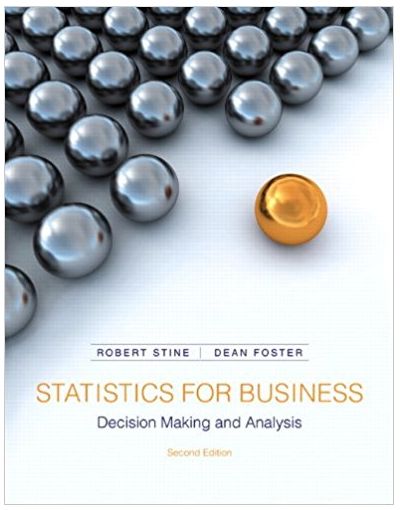When car dealers lease a car, how do they decide what to charge? One answer, if youve
Question:
How should we estimate the residual value of a car? The residual value depends on how much the car was worth originally, such as the manufacturer’s list price. Let’s take this off the table by limiting our attention to a particular type of car. Let’s also assume that we’re looking at cars that have not been damaged in an accident.
What else matters? Certainly the age of the car affects its residual value. Customers expect to pay less for older cars, on average. Older cars have smaller residual value. The term of the lease, say 2 or 3 years, has to cover the cost of the ageing of the car. Another factor that affects the residual value is the type of use. An older car that’s in great condition might be worth more than a newer car that’s been heavily driven. It seems as though the cost of a lease ought to take both duration and use into account.
We’ll use data on the resale prices of used BMW cars gathered online. We introduced these data in an example in Chapter 1. These 185 cars are late-model BMW cars.
Motivation
(a) Why does a manufacturer need to estimate the residual value of a leased car in order to determine annual payments on the lease?
Method
(b) Explain why we should use a multiple regression to estimate the effects of age and mileage simultaneously, rather than use two simple regression models.
(c) The cars are all late-model cars in the same series. Explain why this similarity avoids some of the problems that we have when looking at a cross-section of different types of cars (such as nonlinear patterns or different variances).
(d) Check scatterplots of the variables. Do the relationships appear straight enough to permit using multiple regression with these variables?
Mechanics
(e) Fit the appropriate multiple regression model.
(f) Does this model meet the conditions for using the MRM as the basis for inference?
(g) Build confidence intervals for the partial effects of age and mileage.
Message
(h) Summarize the results of your model. Recommend terms for leases that cover the costs of aging and mileage.
(i) Do you have any caveats that should be pointed out with your recommended terms? For example, are there any evident lurking variables?
Fantastic news! We've Found the answer you've been seeking!
Step by Step Answer:
Related Book For 

Statistics For Business Decision Making And Analysis
ISBN: 9780321890269
2nd Edition
Authors: Robert Stine, Dean Foster
Question Posted:





